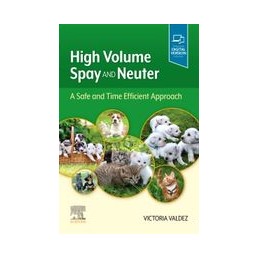- Reduced price

Order to parcel locker

easy pay


 Delivery policy
Delivery policy
Choose Paczkomat Inpost, Orlen Paczka, DPD or Poczta Polska. Click for more details
 Security policy
Security policy
Pay with a quick bank transfer, payment card or cash on delivery. Click for more details
 Return policy
Return policy
If you are a consumer, you can return the goods within 14 days. Click for more details
Approaching high-volume spay and neuter as a separate discipline, this comprehensive reference addresses the unique challenges of this branch of shelter medicine. You will learn how to become faster at performing these procedures in a variety of settings, while still maintaining the safety of the patient. Safety is emphasized throughout with guidance on how to best treat patients with unknown medical histories and financial constraints that restrict the ability to do pre-anesthetic blood work. Special attention is given to considerations about surgical technique, as well as topics such as suture selection and size, suture pattern, patient order, medications, and aftercare. Coverage of mobile veterinary services examines how to provide low-cost spay and neuter to underserved communities with this emerging trend in the industry.
Data sheet
Introduction
Suture Selection and Size for Maximum Safety. (Includes table showing characteristics on commonly used types of suture)
Suture Pattern Selection for Maximum Safety and Efficiency (Including illustrations of various patterns)
Maintaining Sterility (autoclaving, gowns, gloves, scrub, prep)
Prophylactic Antibiotics (considerations such as feral status, post-op environment, possible break in sterility during surgery)
How Order Of Surgical Patients Effects Efficiency
Patient Recovery (Multiple Patients At Once; ways to combat hypothermia, hypoglycemia, dehydration)
Post-Surgical Care At Home. (Take Home Instructions, Where will your emergencies go? E-collars, pain meds, tranquilizers)
Working Was a Team (Each team member has his/her job, consideration for each other=efficiency, how to be safely self-sufficient in surgery)
Large Canine Spay Surgery: Technique, Variations, Troubleshooting.*
Small Canine Spay Surgery: Technique, Variations, Troubleshooting.*
Standard Feline Spay Surgery: Technique, Variations, Troubleshooting.*
Auto-Ligation Feline Spay Surgery: Technique, Variations, Troubleshooting.*
Feline neuter surgery: technique, variations, troubleshooting.*
Ancillary Surgeries: (umbilical hernia repair, dewclaw removal)
What to do in the Case of Complications: (dropped pedicle or stump, incised spleen, incised bladder or bowel, internal bleeding post op)
Being Prepared for Major Complications: (cardiac arrest, spleen or kidney resection)
Tattooing Protocol and Rationale
Ergonomic Considerations and References
Appendix
Reference: 2815
Author: Gerard Loe
Reference: 1118
Author: Krzysztof Fyderek
Reference: 48837
Author: Alan Kaye
Reference: 19878
Author: Katarzyna Michalska-Małecka
